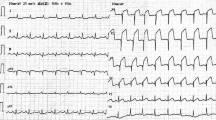Abstract
Transient left ventricular apical ballooning syndrome (TLVABS) is an acute cardiac disease that is characterized by transient left ventricular systolic dysfunction involving the apical region. The symptoms and electrocardiographic changes of TLVABS mimic those observed in acute myocardial infarction while obstructive coronary arterial lesions are not seen in patients with TLVABS. TLVABS usually occurs in elderly women after physical or emotional stress. However, it is very rare in children and so it not well known to pediatricians. Accordingly, TLVABS in children can be misdiagnosed as myocarditis or cardiomyopathy. We report here on a case of child who showed the typical findings of TLVABS in association with pericarditis. He presented with dyspnea and pericardial effusion, which required pericardiocentesis. After pericardiocentesis, he showed the typical echocardiographic and electrocardiographic findings of TLVABS. The MRI findings at 14 days after the initial symptoms showed normal coronary arteries and normal left ventricular function without any wall motion abnormalities. In addition, no delayed hyper enhancement was found on delayed-enhanced (DE)-MRI. We also reviewed the other reported cases of TLVABS in patients who were under the age of 40.




Similar content being viewed by others
References
Denney SD, Lakkireddy DR, Khan IA (2005) Long QT syndrome and torsade de pointes in transient left ventricular apical ballooning syndrome. Int J Cardiol 100(3):499–501
Dote K, Sato H, Tateishi H et al (1991) Myocardial stunning due to simultaneous multi vessel coronary spasms: a review of 5 cases. J Cardiol 21(2):203–214
Jeon JH, Her SH, Lee JM et al (2007) A case of stress-induced cardiomyopathy related with the postpartum period. Korean Circ J 37(8):388–392
Maruyama S, Nomura Y, Fukushige T et al (2006) Suspected takotsubo cardiomyopathy caused by withdrawal of buprenorphine in a child. Circ J 70(4):509–511
Ohwada R, Hotta M, Kimura H et al (2005) Ampulla cardiomyopathy after hypoglycemia in three young female patients with anorexia nervosa. Intern Med 44(3):228–233
Pilgrim TM, Wyss TR (2008) Takotsubo cardiomyopathy or transient left ventricular apical ballooning syndrome: a systematic review. Int J Cardiol 124(3):283–292
Ramakrishna G, Ravi BS, Chandrasekaran K (2005) Apical ballooning syndrome in a postoperative patient with normal microvascular perfusion by myocardial contrast echocardiography. Echocardiography 22(7):606–610
Sasaki O, Nishioka T, Akima T et al (2006) Association of takotsubo cardiomyopathy and long QT syndrome. Circ J 70(9):1220–1222
Sharkey SW, Lesser JR, Zenovich AG et al (2005) Acute and reversible cardiomyopathy provoked by stress in women from the United States. Circulation 111(4):472–479
Takizawa M, Kobayakawa N, Uozumi H et al (2007) A case of transient left ventricular ballooning with pheochromocytoma, supporting pathogenetic role of catecholamines in stress-induced cardiomyopathy or takotsubo cardiomyopathy. Int J Cardiol 114(1):e15–e17
Tsuchihashi K, Ueshima K, Uchida T et al (2001) Transient left ventricular apical ballooning without coronary artery stenosis: a novel heart syndrome mimicking acute myocardial infarction. Angina pectoris-myocardiac infarction investigations in Japan. J Am Coll Cardiol 38(1):11–18
Vultaggio A, Matucci A, Del Pace S et al (2007) Tako-Tsubo-like syndrome during anaphylactic reaction. Eur J Heart Fail 9(2):209–211
Wittstein IS, Thiemann DR, Lima JA et al (2005) Neurohumoral features of myocardial stunning due to sudden emotional stress. N Engl J Med 352(6):539–548
Haghi D, Fluechter S, Suselbeck T et al (2007) Cardiovascular magnetic resonance findings in typical versus atypical forms of the acute apical ballooning syndrome (Takotsubo cardiomyopathy). Int J Cardiol 120(2):205–211
Syed IS, Prasad A, Oh JK et al (2008) Apical ballooning syndrome or aborted acute myocardial infarction? Insights from cardiovascular magnetic resonance imaging. Int J Cardiovasc Imaging 24(8):875–882
Joshi SB, Chao T, Herzka DA et al (2010) Cardiovascular magnetic resonance T2 signal abnormalities in left ventricular ballooning syndrome. Int J Cardiovasc Imaging 26(2):227–232
Author information
Authors and Affiliations
Corresponding author
Rights and permissions
About this article
Cite this article
Lee, S.Y., Lee, S.E., Choi, J.W. et al. A case of transient left ventricular apical ballooning syndrome in a child: clinical features and imaging findings. Int J Cardiovasc Imaging 26 (Suppl 2), 345–351 (2010). https://doi.org/10.1007/s10554-010-9685-1
Received:
Accepted:
Published:
Issue Date:
DOI: https://doi.org/10.1007/s10554-010-9685-1




